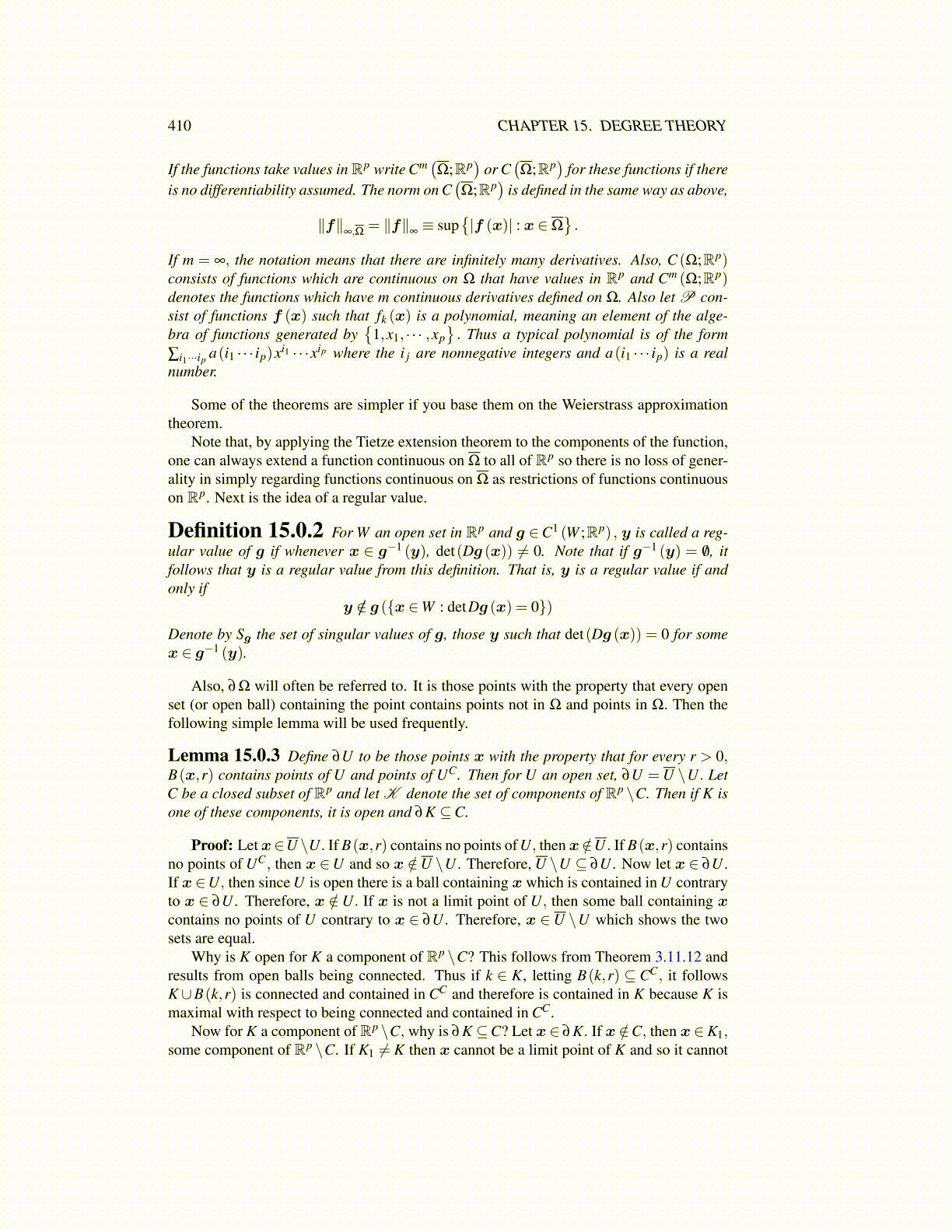
410 CHAPTER 15. DEGREE THEORY
If the functions take values in Rp write Cm(Ω;Rp
)or C
(Ω;Rp
)for these functions if there
is no differentiability assumed. The norm on C(Ω;Rp
)is defined in the same way as above,
∥f∥∞,Ω = ∥f∥
∞≡ sup
{|f (x)| : x ∈Ω
}.
If m = ∞, the notation means that there are infinitely many derivatives. Also, C (Ω;Rp)consists of functions which are continuous on Ω that have values in Rp and Cm (Ω;Rp)denotes the functions which have m continuous derivatives defined on Ω. Also let P con-sist of functions f (x) such that fk (x) is a polynomial, meaning an element of the alge-bra of functions generated by
{1,x1, · · · ,xp
}. Thus a typical polynomial is of the form
∑i1···ip a(i1 · · · ip)xi1 · · ·xip where the i j are nonnegative integers and a(i1 · · · ip) is a realnumber.
Some of the theorems are simpler if you base them on the Weierstrass approximationtheorem.
Note that, by applying the Tietze extension theorem to the components of the function,one can always extend a function continuous on Ω to all of Rp so there is no loss of gener-ality in simply regarding functions continuous on Ω as restrictions of functions continuouson Rp. Next is the idea of a regular value.
Definition 15.0.2 For W an open set in Rp and g ∈C1 (W ;Rp) , y is called a reg-ular value of g if whenever x ∈ g−1 (y), det(Dg (x)) ̸= 0. Note that if g−1 (y) = /0, itfollows that y is a regular value from this definition. That is, y is a regular value if andonly if
y /∈ g ({x ∈W : detDg (x) = 0})
Denote by Sg the set of singular values of g, those y such that det(Dg (x)) = 0 for somex ∈ g−1 (y).
Also, ∂Ω will often be referred to. It is those points with the property that every openset (or open ball) containing the point contains points not in Ω and points in Ω. Then thefollowing simple lemma will be used frequently.
Lemma 15.0.3 Define ∂U to be those points x with the property that for every r > 0,B(x,r) contains points of U and points of UC. Then for U an open set, ∂U = U \U. LetC be a closed subset of Rp and let K denote the set of components of Rp \C. Then if K isone of these components, it is open and ∂K ⊆C.
Proof: Letx∈U \U. If B(x,r) contains no points of U, thenx /∈U . If B(x,r) containsno points of UC, then x ∈U and so x /∈U \U . Therefore, U \U ⊆ ∂U . Now let x ∈ ∂U .If x ∈U, then since U is open there is a ball containing x which is contained in U contraryto x ∈ ∂U . Therefore, x /∈U. If x is not a limit point of U, then some ball containing xcontains no points of U contrary to x ∈ ∂U . Therefore, x ∈U \U which shows the twosets are equal.
Why is K open for K a component of Rp \C? This follows from Theorem 3.11.12 andresults from open balls being connected. Thus if k ∈ K, letting B(k,r) ⊆ CC, it followsK ∪B(k,r) is connected and contained in CC and therefore is contained in K because K ismaximal with respect to being connected and contained in CC.
Now for K a component of Rp \C, why is ∂K ⊆C? Let x ∈ ∂K. If x /∈C, then x ∈ K1,some component of Rp \C. If K1 ̸= K then x cannot be a limit point of K and so it cannot